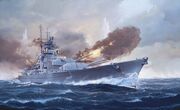
An artists impression of the Dinsmark firing its guns on the Osean fleet during the Battle of Cresence Islands in 1943.
The BRS (Belkan Reichsmarine Service) Dinsmark was a massive battleship that served with the Belkan Reichsmarine during the First Osean Continental War (aka the Second World War). As much a status symbol to Belka as a weapon, the ship was built in the late 1930s to try and obtain parity with other Navies around the world. Indeed, the tried-and-true design of the ship along with its state-of-the-art fire control systems made it arguably one of the best Battleships ever built.
Construction
The keel was laid down for the Dinsmark on May 15th, 1937, and from there construction was fairly rapid, something that the Oseans were wary of after Belka had completed the three Belka-class Heavy Cruisers (known as "Pocket Battleships" by the press) and the two Sudentor-class Battlecruisers in a relatively short timeframe. Within a year, the hull was completed and the ship began its trials, and with the weapons fitted on July 10th, 1938, the ship was christened the Dinsmark, after the man credited with unifying Belka in the late 1800s prior to the Osean War (aka the First World War). The press officially reported that the vessel met the restrictions on tonnage imposed by the Oured Naval Treaty of no more than 35,000 tons, but in reality, the vessel weighed in at 50,300 tons, a justifyable lie in hindsight as Belka wasn't the only one that fudged their numbers when it came to reporting tonnage (the Union of Shiruba and Federal Republic of Erusea were guilty of this as well). At the same time, it was boasted that the Dinsmark could go toe-to-toe with the best of the Osean Navy, and it wouldn't take long for the world to find out, ason January 1st, 1939, the First Osean Continental War began.
Service Life
The Dinsmark was considered a valauble ship, and so it was not to be used lightly, something that the Belkan Admiralty kept in mind as the war's first years went underway. The Dinsmark was immediately the target of Osean efforts to sink it, but it managed to break out of its port at Anfang and into the ocean with escort from two Belkas (one had been sunk already), the two Sudentors and the Heavy Cruiser, Kronprinz Frederik. From there, it was moved to the Cresence Islands to repair damage done to it by heavy deck-penetrating bombs dropped by Osean dive bombers. Only skilled damage-control teams had prevented the complete loss of the Reichsmarine's Ace-in-the hole. By March of 1940, the Dinsmark and its fleet were ready to disembark again, this time to engage the Osean evacuation fleet withdrawing troops from the coast of the Fato Federation. The resulting battle cost Belka another Belka-class and damaged other vessels, but sank the pride of the Osean Navy, the Battlecruiser Invincible. The Dinsmark's fleet continued on, but left behind the Dinsmark as it was leaking fuel and thus needed to return to Cresence for repairs. The Osean fleet relentlessly pursued the Belkan Battleship and severely damaged it, but Belkan aircraft managed to save the stricken ship from being finished off; it would take two whole years to repair the damage done to the Dinsmark.
In 1942, the D'insmark left port again, this time with an escort of four Destroyers and one of the Sudentors (the first was sunk a month prior) and the Aircraft Carrier BRS Waldreich, but this time ran into a large Osean naval task force dispatched to destroy the Reichsmarine. The resulting battle was costly for both sides, mostly in carrier aircraft but nevertheless several ships were damaged. Miraculously, the Dinsmark was untouched, and no ships on either side were sunk. The ships made it out of Cresence to another port at Anfang, but the Oseans decided to switch strategies: they placed submarines at the exit of the harbor, which blockaded the Belkan fleet into the harbor. They would remain here for the remaining five years of the war.
At the end of the war, the Belkan Navy was forcibly downsized, but they were allowed to keep the Dinsmark if only because the war had given the impression that battleships had been rendered obsolete (they weren't so lucky with Dinsmark's sister ship Hofffnung, which was sunk in 1944). Even so, over the years the Dinsmark was upgraded with newer weapons and frie control systems, allowing the vessel to remain on par with Osea's own upgraded battleships of the Iowa-class. This allowed the vessel to serve in the Belkan War for a few weeks, but in April of 1995, the Dinsmark took a hit from a cruise missile that rendered it non-seaworthy for the remainder of the war. In 2015, the Dinsmark served one final time as part of the Belkan Expeditionary Force sent to assist Emmeria, providing fire support for allied troops with its 15-inch guns and Tomahawk cruise missiles. Following this, the vessel was finally retired from service and converted into a museum ship, which it remains to this day.
Specifications
Class and Type: Dinsmark-class Battleship
Displacement: 41,700 tons standard, 50,300 tons fully-loaded
Length: 823 feet
Beam: 118 feet
Draft: 31 feet standard
Powerplant: 12 Wagner superheated boilers; 3 geared turbines; 3 three-blade screws developing 150,170 shaft horsepower
Speed: 30.01 Knots during trials
Range: 8,870 nautical miles at 19 knots
Compliment: 103 officers, 1,962 enlisted men
Armament:
- 8 × 15 in SK C/34 (4 × 2)
- 12 × 5.9 in (6 × 2)
- 16 × 4.1 in SK C/33 (8 × 2)
- 16 × 1.5 in SK C/30 (8 × 2)
- 12 × 0.79 in Flak 30 (12 × 1)
Armor:
- Belt: 13 in
- Turrets: 14 in
- Deck: 3.9-4.7 in
Aircraft Carried: 4 x Arado Ar 196 Floatplanes
Aircraft Facilities: 1 x Double-Ended Catapult
